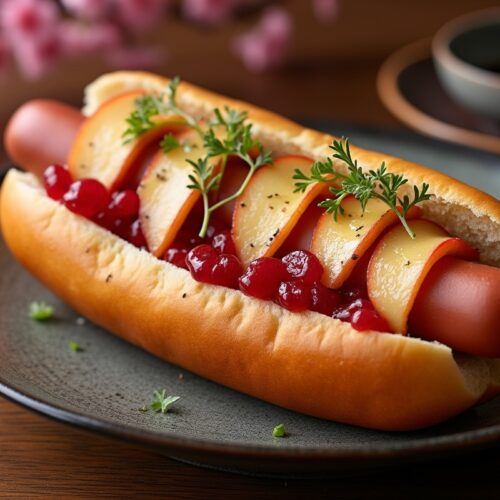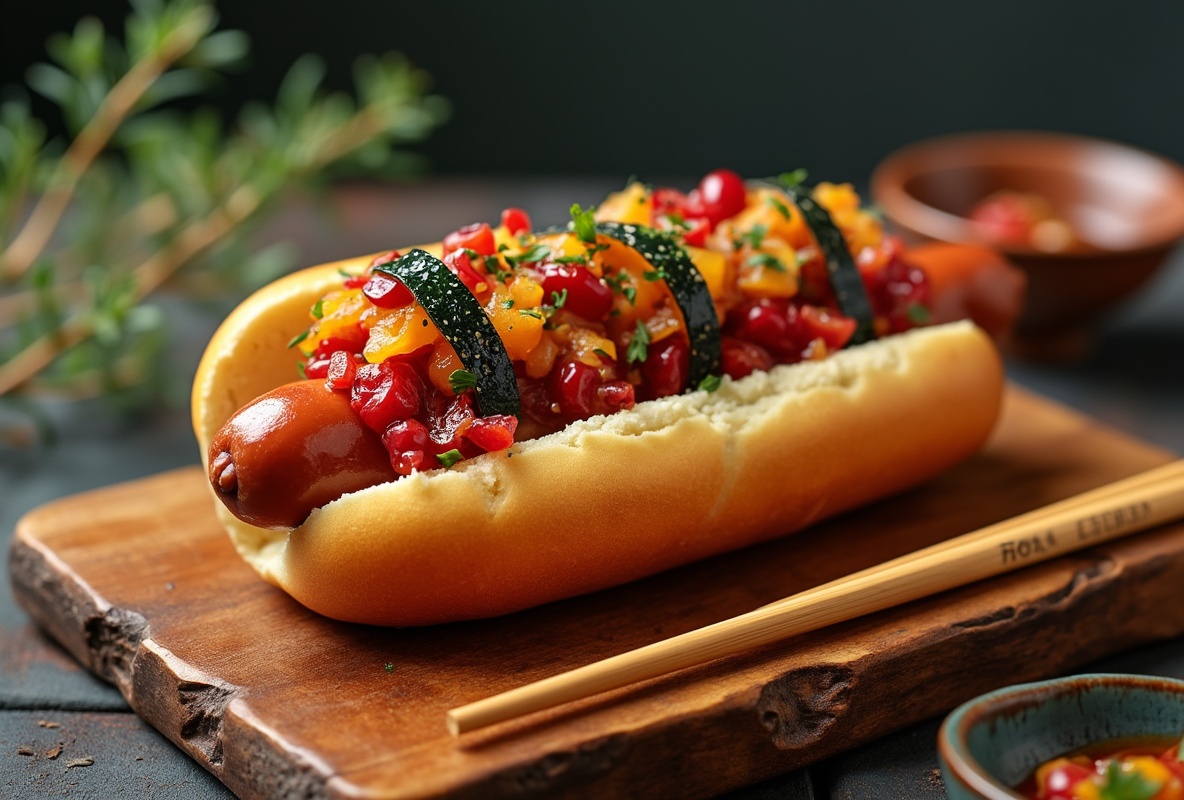Discover the World of Japanese-Inspired Hot Dogs
Exploring the vibrant world of Japanese hot dog ingredients opens a gateway to a fusion of flavors unlike any other. This unique twist on the classic hot dog brings in savory elements from Japan that promise to tantalize your taste buds. From tangy teriyaki sauce to crisp nori and creamy Kewpie mayo, these ingredients craft a delicious experience. Transitioning from traditional to extraordinary, these hot dogs invite not just a meal but a culinary journey that celebrates creativity and cultural fusion. Whether you’re a seasoned foodie or a curious cook, the adventure begins with the ingredients.
The Essential Ingredients for Authentic Japanese Hot Dogs
Japanese Hot Dog Ingredients are what make these delectable treats so unique and flavorful. At the heart of the recipe is the teriyaki sauce, which provides a sweet and savory glaze often balanced with a touch of umami. Top-quality sausages or hot dog links form the foundation, usually grilled to smoky perfection. Kewpie mayonnaise, a beloved staple in Japanese cuisine, offers a creamy, tangy contrast. Additionally, crisp nori strips and fresh cabbage slaw add texture and a burst of color either on top or as a delightful garnish. For those seeking extra flavor, incorporating pickled ginger or a sprinkle of toasted sesame seeds can enhance the overall taste experience. Because each element complements the other, these ingredients come together to create a harmony of flavors that distinguishes Japanese hot dogs from traditional versions. Plus, using fresh and high-quality components ensures every bite is packed with authentic, mouthwatering flavor.
For ideas on how to adapt creative combinations of toppings, explore dishes like Mexican sushi name explained, which showcases a unique cultural twist on traditional formats.
Mastering Your First Japanese Hot Dog Recipe
To create an unforgettable culinary experience, understanding the essentials of Japanese Hot Dog Ingredients is crucial. Start with a quality sausage, often made from pork or beef, providing a savory foundation that enhances the hot dog. The addition of umami-rich toppings like shredded nori, pickled ginger, and wasabi mayo takes your taste buds on a flavorful journey. Because these ingredients are so distinct, it’s important to balance their boldness with subtle flavors like toasted sesame seeds and finely chopped green onions. Furthermore, consider using a steamed or toasted bun to add texture and warmth.
For more tips on balancing bold flavors with subtle textures, you might enjoy reading how unique mashups like ramen burger inventor history can inspire creative cooking techniques.
Creating a Japanese-inspired hot dog at home can initially seem daunting, but breaking it down into manageable steps makes it achievable. Let’s walk through the recipe together to bring this to life.

Japanese-Style Hot Dogs
Equipment
- Grill or grill pan
- Small saucepan
- Basting brush
- Serving plate
- Knife
- Cutting board
Ingredients
- 4 hot dog buns
- 4 hot dogs grilled or cooked
- 1/4 cup teriyaki sauce store-bought or homemade
- 2 tbsp Japanese mayo
- 1/2 cup shredded nori sheets seaweed strips
- 1/4 cup pickled ginger thinly sliced
- 1/4 cup crispy fried onions as topping
- 1 tbsp sesame seeds toasted
- 1 tsp sriracha sauce optional, for spice
Instructions
- Preheat the grill or grill pan and cook the hot dogs until heated through and lightly charred, about 5-7 minutes.
- Warm the hot dog buns on the grill for 1-2 minutes, until slightly toasted.
- Heat the teriyaki sauce in a small saucepan over low heat for 2-3 minutes.
- Place the grilled hot dogs inside the warmed buns.
- Drizzle the teriyaki sauce over the hot dogs using a basting brush or spoon.
- Top each hot dog with a drizzle of Japanese mayo.
- Sprinkle shredded nori, pickled ginger, crispy fried onions, and toasted sesame seeds over the hot dogs.
- For added spice, drizzle sriracha sauce on top, if desired.
- Serve immediately and enjoy these flavorful Japanese-style hot dogs!
Notes
Unique Flavors: Exploring Regional Variations of Japanese Hot Dogs
Exploring the diverse Japanese hot dog ingredients transforms a simple snack into a fusion of vibrant flavors. Each region in Japan introduces its twist, using unique ingredients like wasabi mayo, nori seaweed, and pickled ginger. In Osaka, known for its bold street food culture, you might find hot dogs topped with okonomiyaki sauce and bonito flakes, offering a savory and smoky taste. Meanwhile, in Hokkaido, the focus shifts to incorporating fresh seafood toppings, embracing the local bounty. These culinary innovations highlight the creativity in pairing flavors and textures, resulting in a deliciously unconventional hot dog experience. What’s even more fascinating is how these combinations cater to both traditional palates and adventurous tastes, making every bite a journey. Learning about regional variations not only improves your culinary repertoire but also prepares you for experimenting with these flavors. Let’s dive into the perfect pairings for these delightful creations.
Perfect Pairings: Side Dishes to Complement Japanese Hot Dogs
When savoring Japanese Hot Dog Ingredients, pairing them with the right side dishes can truly elevate the dining experience. Think of including a crisp seaweed salad or lightly pickled daikon for a refreshing contrast to the hearty flavors of the hot dog. Moreover, a serving of steamed edamame or miso soup can complement the main dish beautifully, adding both texture and warmth. For a touch of fusion flair, consider wasabi-flavored French fries or ginger-infused coleslaw. These sides not only balance the rich taste of the hot dogs but also highlight the Japanese culinary influences. If you’re a fan of fusion dishes, explore the essential knife skills for home cooks when preparing your vegetables to craft these side dishes beautifully. Therefore, embracing these side options enhances the overall meal’s harmony, creating a delightful and memorable experience. This aspect of the dish opens up a world of culinary possibilities worth exploring further.
Turning Traditional: Tweaking Japanese Hot Dog Ingredients for Home Cooks
If you’re looking to recreate these delightful treats at home, tweaking Japanese Hot Dog Ingredients can make all the difference. Start with a quality sausage—perhaps opting for a chicken or tofu version for a healthier twist. Swap the traditional teriyaki sauce with a homemade soy-miso blend to add an umami-rich bite. Adding a sprinkle of furikake, a popular Japanese seasoning made with seaweed and sesame seeds, instantly elevates the flavor profile. You might consider incorporating unique elements like pickled ginger for a tangy contrast or even avocado slices for a creamy touch. Moreover, experimenting with different types of buns, like a brioche or a whole wheat roll, can change the texture and taste experience entirely. For instance, making these substitutions allows you to still capture the essence while accommodating dietary preferences or resource availability. For vegetarian alternatives, consider exploring vegan mac and cheese ingredients for inspiration in crafting plant-based toppings. This perspective broadens our understanding and sets the stage for even more exciting insights.
Pro Tips for Presenting and Serving Japanese Hot Dogs
Presenting Japanese-style hot dogs with flair makes them even more appetizing. First, arrange the hot dog in a way that highlights its vibrant toppings. Think of delicate drizzles of Japanese mayonnaise and a sprinkle of toasted sesame seeds that add not just flavor, but a visual wow factor. Meanwhile, serving your creation on a rustic wooden board or a colorful ceramic plate can add a touch of authenticity. Don’t forget to include a small bowl of tangy pickled ginger on the side as an unexpected treat. For those eager to tweak the Japanese hot dog ingredients, consider adding chopped scallions or a dash of spicy seasoning for an extra kick. Finally, use chopsticks as both serving tools and decorations—they’re practical yet thematic additions. For more creative serving ideas and inspiration, you can check out how to enhance sloppy joe dishes with cranberry-orange relish. As a result, these small details bring the whole dish together, creating a memorable dining experience for your guests. This exploration leaves us inspired to embrace more creativity in the kitchen.
Frequently Asked Questions
How can I prepare Japanese Hot Dog Ingredients ahead of time?
If you’re pressed for time, Japanese Hot Dog Ingredients can be prepared in advance. Chop and arrange your toppings, then store them in airtight containers in the refrigerator. Assemble your hot dogs just before serving to ensure they remain fresh and flavorful.
What common challenges might arise when making Japanese Hot Dog Ingredients?
Common challenges can include balancing flavors or achieving the right texture. Ensure your ingredients are fresh and check seasoning levels as you prepare your toppings. This helps maintain the authentic taste without overpowering any element.
Can I adapt Japanese Hot Dog Ingredients for different dietary preferences?
Absolutely! Japanese Hot Dog Ingredients are versatile. You can substitute with vegetarian sausage or gluten-free buns to cater to dietary needs. Explore plant-based toppings or sauces to accommodate vegan preferences while still retaining traditional flavors.
How should I store leftovers of Japanese Hot Dog Ingredients?
Store any leftover Japanese Hot Dog Ingredients in airtight containers in the fridge for up to three days. When ready to reheat, gently warm the components separately to maintain their original textures and flavors. Avoid reheating the assembled hot dogs to prevent sogginess.
What are the best pairings for Japanese Hot Dog Ingredients?
Japanese Hot Dog Ingredients pair well with a side of miso soup or a crisp seaweed salad. These dishes enhance the unique flavors of the hot dog, creating a balanced and satisfying meal that marries different textures and tastes beautifully. If you’re curious about how other dishes pair with Japanese flavors, consider trying curry pasta flavor combinations for more adventurous culinary explorations.

